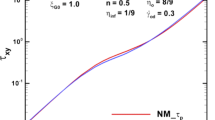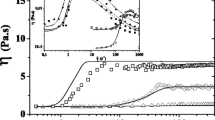Abstract
This study is concerned with the finite element/finite volume (fe/fv) simulation of thixotropic and viscoelastoplastic material systems through two model approaches: (i) a new micellar thixotropic constitutive model for wormlike micellar systems (that introduces viscoelasticity into the network structure construction/destruction kinetic equation) and (ii) adopting a Bingham–Papanastasiou model. The computational approach is based on a hybrid parent/subcell scheme, which is cast about a semi-implicit incremental pressure correction (ipc) scheme. The appearance of plastic behaviour arises through the micellar polymeric viscosity, by increasing the zero-shear viscosity (low solvent fractions), whilst the Bingham–Papanastasiou introduces plastic features through the solvent viscosity. The characteristics of thixotropic wormlike micellar systems are represented through the class of Bautista–Manero models. Correction is incorporated, based on physical arguments for fluidity, in which absolute values of the dissipation function are adopted in complex flow, thereby accessing low-solvent fractions and high-elasticity levels. Considering elastic and plastic influences separately, solutions are compared and contrasted for contraction–expansion flow, identifying such flow field features as vortex dynamics, stress field structure, yield front patterns and enhanced pressure drop. Particular attention is paid to the influence of enhanced strain hardening that is introduced through stronger thixotropic structural features. Vortex activity decreases as either We is increased at a fixed τ 0 or τ 0 is increased at a fixed We. Exaggerated strain-hardening properties are observed to have a major impact on vortex activity. Patterns and trends in normal stress difference fields reflect those in re-entrant corner vortex patterns. Yield front patterns are significantly influenced with yield stress τ 0 variation and more so than elevation in elasticity. Findings on excess pressure drop (epd) versus increased yield stress (τ 0) follow a linear trend. Consistently, it is evident that any variation that leads to a more solid-like behaviour produces epd enhancement. In addition, relatively more structured fluids display distinctly larger epd values throughout the τ 0 range covered.












Similar content being viewed by others
References
Aboubacar M, Matallah H, Tamaddon-Jahromi HR, Webster MF (2002a) Numerical prediction of extensional flows in contraction geometries: hybrid finite volume/element method. J Non-Newton Fluid Mech 104:125–164
Aboubacar M, Matallah H, Webster MF (2002b) Highly elastic solutions for Oldroyd- B and Phan-Thien/Tanner fluids with a finite volume/element method: planar contraction flows. J Non-Newton Fluid Mech 103:65–103
Aguayo JP, Tamaddon-Jahromi HR, Webster MF (2008) Excess pressure-drop estimation in contraction and expansion flows for constant shear-viscosity, extension strain-hardening fluids. J Non-Newton Fluid Mech 153:157–176
Al-Muslimawi A, Tamaddon-Jahromi HR, Webster MF (2013) Simulation of viscoelastic and viscoelastoplastic die swell flows. J Non-Newton Fluid Mech 191:45–56
Barnes HA (1999) The yield stress—a review or ‘παντα ρει’—everything flows? J Non-Newton Fluid Mech 81:133–178
Barnes HA, Walters K (1985) The yield stress myth? Rheol Acta 23:323–326
Bautista F, de Santos JM, Puig JE, Manero O (1999) Understanding thixotropic and antithixotropic behavior of viscoelastic micellar solutions and liquid crystalline dispersions. I. The model. J Non-Newton Fluid Mech 80:93–113
Bautista F, Soltero JFA, Pérez-López JH, Puig JE, Manero O (2000) On the shear-banding flow of elongated micellar solutions. J Non-Newton Fluid Mech 94:57–66
Belblidia F, Matallah H, Webster MF (2008) Alternative subcell discretisations for viscoelastic flow: velocity-gradient approximation. J Non-Newt Fluid Mech 151:69–88
Belblidia F, Tamaddon-Jahromi HR, Webster MF, Walters K (2011) Computations with viscoplastic and viscoelastoplastic fluids. Rheol Acta 50:343–360
Binding DM, Phillips PM, Phillips TN (2006) Contraction/expansion flows: the pressure drop and related issues. J Non-Newton Fluid Mech 137:31–38
Bingham EC (1922) Fluidity and plasticity. McGraw Hill, New York
Boek ES, Padding JT, Anderson VJ, Tardy PMJ, Crawshaw JP, Pearson JRA (2005) Constitutive equations for extensional flow of wormlike micelles: stability analysis of the Bautista-Manero model. J Non-Newton Fluid Mech 126:29–46
Bonn D (2006) Yield stress fluids: to flow or not to flow, that is the question. Viscoplastic fluids: from theory to application, Cyprus
Calderas F, Herrera-Valencia EE, Sanchez-Solis A, Manero O, Medina-Torres L, Renteria A, Sanchez-Olivares G (2013) On the yield stress of complex materials. Korea-Aust Rheol J 25:233–242
de Souza PR (2009) Modeling the thixotropic behaviour of structured fluids. J Non-Newton Fluid Mech 164:66–75
de Souza PR (2011) Thixotropic elasto-viscoplastic model for structured fluids. Soft Matter 7:2471–2483
de Souza PR, Thompson RL (2012) A critical overview of elasto-viscoplastic thixotropic behaviour modeling. J Non-Newton Fluid Mech 187–188:8–15
Frigaard IA, Nouar C (2005) On the usage of viscosity regularisation methods for visco-plastic fluid flow computation. J Non-Newton Fluid Mech 127:1–26
Hartnett JP, Hu RYZ (1989) Technical note: the yield stress—an engineering reality. J Rheol 33:671–679
Hermany L, dos Santos DD, Frey S, Naccache MF, de Souza PR (2013) Flow of yield-stress liquids through an axisymmetric abrupt expansion-contraction. J Non-Newton Fluid Mech 201:1–9
Huilgol RR, You Z (2005) Application of the augmented Lagrangian method to steady pipe flows of Bingham, Casson and Herschel–Bulkley fluids. J Non-Newtonian Fluid Mech 128:126–143
López-Aguilar JE, Webster MF, Tamaddon-Jahromi HR, Manero O (2014a) A new constitutive model for worm-like micellar systems—numerical simulation of confined contraction-expansion flows. J Non-Newton Fluid Mech 204:7–21
López-Aguilar JE, Webster MF, Tamaddon-Jahromi HR, Manero O (2014b) High-Weissenberg predictions for micellar fluids in contraction-expansion flows. J Non-Newton Fluid Mech Under review
Manero O, Bautista F, Soltero JFA, Puig JE (2002) Dynamics of worm-like micelles: the Cox-Merz rule. J Non-Newton Fluid Mech 106:1–15
Matallah H, Townsend P, Webster MF (1998) Recovery and stress-splitting schemes for viscoelastic flows. J Non-Newton Fluid Mech 75:139–166
Mitsoulis E (2007) Flows of viscoplastic materials: models and computations. Rheol Rev 135–178
Møller PCF, Mewis J, Bonn D (2006) Yield stress and thixotropy: on the difficulty of measuring yield stresses in practice. Soft Matter 2:274–288
Muravleva L, Muravleva E, Georgiou GC, Mitsoulis E (2010) Numerical simulations of cessation flows of a Bingham plastic with the augmented Lagrangian method. J Non-Newton Fluid Mech 165:544–550
Papanastasiou TC (1987) Flow of materials with yield. J Rheol 31:385–404
Renardy M (2010) The mathematics of myth: yield stress behaviour as a limit of non-monotone constitutive theories. J Non-Newton Fluid Mech 165:519–526
Roquet N, Saramito P (2001) An adaptive finite element method for viscoplastic fluid flows in pipes. Comput Methods Appl Mech Eng 190:5391–5412
Rothstein JP, McKinley GH (2001) The axisymmetric contraction–expansion: the role of extensional rheology on vortex growth dynamics and the enhanced pressure drop. J Non-Newton Fluid Mech 98:33–63
Saramito P (2007) A new constitutive equation for elastoviscoplastic fluid flows. J Non-Newton Fluid Mech 145:1–14
Tamaddon-Jahromi HR, Webster MF (2011) Transient behaviour of branched polymer melts through planar abrupt and rounded contractions using pom-pom models. Mech Time-Depend Mater 15:181–211
Walters K, Webster MF (2003) The distinctive CFD challenges of computational rheology. Int J Numer Meth Fluids 43:577–596
Wapperom P, Webster MF (1998) A second-order hybrid finite-element/volume method for viscoelastic flows. J Non-Newton Fluid Mech 79:405–431
Webster MF, Tamaddon-Jahromi HR, Aboubacar M (2005) Time-dependent algorithms for viscoelastic flow: finite element/volume schemes. Numer Meth Part Differ Eq 21:272–296
Yang J (2002) Viscoelastic wormlike micelles and their applications. Curr Opin Colloid Interface Sci 7:276–281
Acknowledgments
Financial support (scholarship to J.E.L.-A.) from the Consejo Nacional de Ciencia y Tecnología (CONACYT, México), Zienkiewcz College of Engineering scholarship and NHS Wales Abertawe Bro Morgannwg Trust Fund is gratefully acknowledged.
Author information
Authors and Affiliations
Corresponding author
Rights and permissions
About this article
Cite this article
López-Aguilar, J.E., Webster, M.F., Tamaddon-Jahromi, H.R. et al. Numerical modelling of thixotropic and viscoelastoplastic materials in complex flows. Rheol Acta 54, 307–325 (2015). https://doi.org/10.1007/s00397-014-0810-2
Received:
Revised:
Accepted:
Published:
Issue Date:
DOI: https://doi.org/10.1007/s00397-014-0810-2




